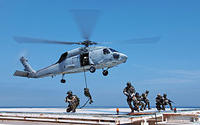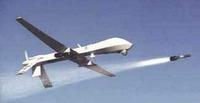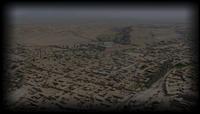-
USAF partners with national labs to improve aircraft component design
Working with national laboratories, universities, and industry, the Air Force is ensuring it stays on the cutting edge of global security by creating a new engineering paradigm to improve the safety and fuel-efficiency of aircraft.Materials research engineers at the Air Force Research Laboratory (AFRL) have partnered with national laboratories to model defects and study materials at their grain level in an effort to develop and advance the design of systems used by the military personnel, including aircraft.
-
-
Greater role for Pentagon in next phase of U.S. war on terror

The Obama administration had dramatically increased the use of drones in the war against terrorists. The number of drone strike has declined this year relative to the high levels of 2010-11. The number of drone strikes may increase again, but this past weekend’s Special Forces raids in Somalia and Libya are an indication that the next phase in the U.S. war on terrorism would see, in relative terms, less of a reliance on CIA-operated drones and a greater role for the Pentagon.
-
-
Aerospace and Defense Industry says its member companies negatively affected by shutdown
The Aerospace Industries Association called on Congress and President Obama to pass a bipartisan solution that reopens the government as soon as possible. The association’s president said that the negative impacts of the shutdown range from industry worker furloughs on programs that support the soldiers to delays in new aircraft certification and space systems launches.
-
-
Preventing nuclear terrorism

Nuclear terrorism remains a real and urgent threat. Despite an array of mechanisms established to combat this threat, several serious problems persist, requiring relentless attention and actions by the United States, Russia, and other responsible nations. These problems include continuing nuclear security vulnerabilities in a number of countries and the continued incidents of illicit trafficking in nuclear materials, radioactive sources, and the various components.
-
-
Reducing security threats from explosives
Researchers, as part of the Awareness and Localization of Explosives-Related Threats center (ALERT), a DHS Center of Excellence, are working on ways to detect explosives and neutralize their impact. The researchers are developing portable detectors as well as larger systems to scan for explosives. Some technologies will analyze the spectrum of light shining through vaporized samples; others will analyze solid residues.
-
-
New technology spots killer waves
Sailors throughout the ages have wished they could predict the strength and size of the next wave. The Environmental and Ship Motion Forecasting (ESMF) system, a Future Naval Capability effort supported by the Office of Naval Research’s (ONR) Sea Warfare and Weapons Department, seeks to provide sea-based forces with new capabilities for difficult operations like ship-to-ship transfer of personnel, vehicles, or materiel — giving operators sea condition information at levels of accuracy never possible before.
-
-
Innovations help lighten the load for marines
The Office of Naval Research (ONR) was at the Modern Day Marine exposition last week, showcasing some of the newest technologies it has helped develop to give sailors and marines the edge. The Expeditionary Maneuver Warfare and Combating Terrorism Department at ONR highlighted its focused initiatives to lighten the load for marines, including integrated day/night vision sights, scalable body armor, and other research which will help marines out-think, out-maneuver, and out-perform the enemy.
-
-
Syria’s chemical weapons can be destroyed within nine months: experts
Weapons experts from the United States and Russia say most of Syria’s chemical weapons stockpile are kept as unweaponized liquid precursors, and thus could be neutralized in a short period of time without the risk that toxins could be stashed away by the regime for future use, or stolen by terrorists. A confidential assessment by the United States and Russia concludes that Syria’s entire arsenal could be destroyed in about nine months, assuming that Syrian officials fully cooperate with the weapons inspectors.
-
-
DARPA Young Faculty meet next generation of Army tech users
Recipients of the DARPA Young Faculty Award (YFA) visited the United States Military Academy at West Point during its first Branch Week, 10-15 September 2013. The event brought “several hundred tons of military equipment, vehicles and weapons for the academy’s spin on a college career fair,” one observer said.
-
-
Al Qaeda increases efforts to defeat U.S. drones

Drone attacks have been an important part of America’s war against terrorism. These airstrikes have considerably limited the movements and operational freedom of al Qaeda operatives and other militants in Pakistan, Afghanistan, Yemen, and Somalia. Al Qaeda has been exploring strategies and experts to allow it to counter America’s drone campaign.
-
-
Compact aerostat offers affordable, portable surveillance solution

Columbia, Maryland-based TCOM last week unveiled its newest aerostat platform, the 12M Tactical Aerostat. The system is designed to meet the needs of soldiers and first responders who require a compact, affordable, persistent surveillance solution which can be transported anywhere, rapidly deployed, and easily retrieved.
-
-
Iran indicates willingness to rethink nuclear program in exchange for sanction relief
As part of a series of steps designed to present post-election Iran as more pragmatic, President Hassan Rouhani and his advisers indicated they would be willing to consider curbs on Iran’s nuclear program in exchange for relief from the crippling economic sanctions imposed on Iran. Some Western experts say that all these steps are more than mere cosmetic changes, while skeptics note that Obama has reached out to Iran before, with no results. Veterans of past nuclear negotiations with Iran also noted that it is likely that Rouhani’s team may not yet fully understand the kinds of concessions that the Islamic republic would be required to make to have the most painful economic sanctions lifted.
-
-
UN inspectors' repot on gas attack points to Assad’s elite military units
Russia may say publicly that it does not know who launched the deadly 21 August gas attack on two Damascus neighborhoods, but the Russians must have had an inkling: Russia’s UN ambassador agreed to have an international team of weapon inspectors sent to Syria to investigate the 21 August attack on one condition: the inspectors’ mandate was narrowed to verifying that chemical weapons were used, but specifically prohibited the inspectors from assigning responsibility to the attack. Russia’s effort to shield Assad has resulted in a report, submitted Monday to the UN Security Council, which does not explicitly name the Syrian regime as the party launching the attack, but details buried in the report point directly at elite military formations loyal to Assad.
-
-
U.S. still has 3,100 tons of chemical weapons to be destroyed
Last weekend’s U.S.-Russia agreement on Syria’s chemical weapons has put on hold a U.S. strike on Syria. The pause may allow a reflection on the fact that the United States possesses one of the world’s largest chemical arsenals. Sixteen years after a treaty banning of chemical weapons went into effect, the Unites States has 3,100 tons stored in Colorado and Kentucky.
-
-
History of explosives highlighted in museum exhibit
For more than seventy years, Los Alamos National Laboratory has been a frontrunner in explosives research, development, and applications. To highlight the Laboratory’s work in the field of explosives, the Bradbury Science Museum is opening a new exhibit, titled “The Science of Explosives.”
-
More headlines
The long view
Factories First: Winning the Drone War Before It Starts
Wars are won by factories before they are won on the battlefield,Martin C. Feldmann writes, noting that the United States lacks the manufacturing depth for the coming drone age. Rectifying this situation “will take far more than procurement tweaks,” Feldmann writes. “It demands a national-level, wartime-scale industrial mobilization.”
